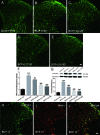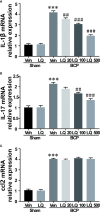Liquiritin Alleviates Pain Through Inhibiting CXCL1/CXCR2 Signaling Pathway in Bone Cancer Pain Rat
- PMID: 32390832
- PMCID: PMC7193085
- DOI: 10.3389/fphar.2020.00436
Liquiritin Alleviates Pain Through Inhibiting CXCL1/CXCR2 Signaling Pathway in Bone Cancer Pain Rat
Abstract
Bone cancer pain (BCP) is an intractable clinical problem, and lacked effective drugs for treating it. Recent research showed that several chemokines in the spinal cord are involved in the pathogenesis of BCP. In this study, the antinociceptive effects of liquiritin, which is an active component extracted from Glycyrrhizae Radix, were tested and the underlying mechanisms targeting spinal dorsal horn (SDH) were investigated. The BCP group displayed a significant decrease in the mechanical withdrawal threshold on days 6, 12, and 18 when compared with sham groups. Intrathecal administration of different doses of liquiritin alleviated mechanical allodynia in BCP rats. The results of immunofluorescent staining and western blotting showed that liquiritin inhibited BCP-induced activation of astrocytes in the spinal cord. Moreover, intrathecal administration of liquiritin effectively inhibited the activation of CXCL1/CXCR2 signaling pathway and production of IL-1β and IL-17 in BCP rats. In astroglial-enriched cultures, Lipopolysaccharides (LPS) elicited the release of chemokine CXCL1, and the release was decreased in a dose-dependent manner by liquiritin. In primary neurons, liquiritin indirectly reduced the increase of CXCR2 by astroglial-enriched-conditioned medium but not directly on the CXCR2 target site. These results suggested that liquiritin effectively attenuated BCP in rats by inhibiting the activation of spinal astrocytic CXCL1 and neuronal CXCR2 pathway. These findings provided evidence regarding the the antinociceptive effect of liquiritin on BCP.
Keywords: CXCL1; CXCR2; bone cancer pain; glia-neuron interaction; liquiritin; spinal cord.
Copyright © 2020 Ni, Xu, Xie, Fei, Deng, He, Wang, Liu, Zhu, Xu and Yao.
Figures









Similar articles
-
NFκB-mediated CXCL1 production in spinal cord astrocytes contributes to the maintenance of bone cancer pain in mice.J Neuroinflammation. 2014 Mar 1;11:38. doi: 10.1186/1742-2094-11-38. J Neuroinflammation. 2014. PMID: 24580964 Free PMC article.
-
Crosstalk between NFκB-dependent astrocytic CXCL1 and neuron CXCR2 plays a role in descending pain facilitation.J Neuroinflammation. 2019 Jan 3;16(1):1. doi: 10.1186/s12974-018-1391-2. J Neuroinflammation. 2019. PMID: 30606213 Free PMC article.
-
Levo-corydalmine alleviates vincristine-induced neuropathic pain in mice by inhibiting an NF-kappa B-dependent CXCL1/CXCR2 signaling pathway.Neuropharmacology. 2018 Jun;135:34-47. doi: 10.1016/j.neuropharm.2018.03.004. Epub 2018 Mar 5. Neuropharmacology. 2018. PMID: 29518397
-
The analgesic effects of pioglitazone in the bone cancer pain rats via regulating the PPARγ/PTEN/mTOR signaling pathway in the spinal dorsal horn.Biomed Pharmacother. 2020 Nov;131:110692. doi: 10.1016/j.biopha.2020.110692. Epub 2020 Sep 14. Biomed Pharmacother. 2020. PMID: 32942156
-
Chemokines and Their Receptors: Potential Therapeutic Targets for Bone Cancer Pain.Curr Pharm Des. 2015;21(34):5029-33. doi: 10.2174/1381612821666150831141931. Curr Pharm Des. 2015. PMID: 26320755 Review.
Cited by
-
Interleukin-17: A Putative Novel Pharmacological Target for Pathological Pain.Curr Neuropharmacol. 2024;22(2):204-216. doi: 10.2174/1570159X21666230811142713. Curr Neuropharmacol. 2024. PMID: 37581321 Free PMC article. Review.
-
Autonomic Nervous System Dysfunction Is Related to Chronic Prostatitis/Chronic Pelvic Pain Syndrome.World J Mens Health. 2024 Jan;42(1):1-28. doi: 10.5534/wjmh.220248. Epub 2023 Apr 19. World J Mens Health. 2024. PMID: 37118962 Free PMC article. Review.
-
Senso-Immunologic Prospects for Complex Regional Pain Syndrome Treatment.Front Immunol. 2022 Jan 5;12:786511. doi: 10.3389/fimmu.2021.786511. eCollection 2021. Front Immunol. 2022. PMID: 35069559 Free PMC article. Review.
-
Role of TRP Channels in Cancer-Induced Bone Pain.Int J Mol Sci. 2025 Jan 30;26(3):1229. doi: 10.3390/ijms26031229. Int J Mol Sci. 2025. PMID: 39940997 Free PMC article. Review.
-
Protective effects of liquiritin on polycystic ovary syndrome through modulating ovarian granulosa cell proliferation and apoptosis via miR-206/PI3K/AKT pathway.Cytotechnology. 2022 Jun;74(3):385-393. doi: 10.1007/s10616-022-00531-5. Epub 2022 Mar 21. Cytotechnology. 2022. PMID: 35733703 Free PMC article.
References
-
- Cao D. L., Zhang Z. J., Xie R. G., Jiang B. C., Ji R. R., Gao Y. J. (2014). Chemokine CXCL1 enhances inflammatory pain and increases NMDA receptor activity and COX-2 expression in spinal cord neurons via activation of CXCR2. Exp. Neurol. 261, 328–336. 10.1016/j.expneurol.2014.05.014 - DOI - PMC - PubMed
LinkOut - more resources
Full Text Sources

